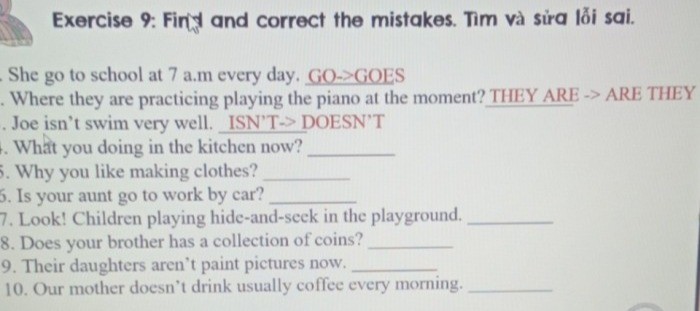* She go to school at 7 a.m every day.
* Sửa: She goes to school at 7 a.m every day.
* Giải thích: Chủ ngữ "She" là ngôi thứ ba số ít nên động từ phải chia ở dạng số ít là "goes".
* Where they are practicing playing the piano at the moment?
* Sửa: Where are they practicing playing the piano at the moment?
* Giải thích: Câu hỏi bắt đầu bằng "Where" nên đảo trợ động từ "are" lên trước chủ ngữ "they".
* Joe isn't swim very well.
* Sửa: Joe doesn't swim very well.
* Giải thích: Để diễn tả khả năng hoặc thói quen, ta dùng thì hiện tại đơn với trợ động từ "do/does" và động từ nguyên mẫu.
* What you doing in the kitchen now?
* Sửa: What are you doing in the kitchen now?
* Giải thích: Đây là câu hỏi đang diễn ra nên dùng thì hiện tại tiếp diễn, cấu trúc: am/is/are + V-ing.
* Why you like making clothes?
* Sửa: Why do you like making clothes?
* Giải thích: Tương tự câu 3, để hỏi về sở thích, ta dùng thì hiện tại đơn với trợ động từ "do/does".
* Is your aunt go to work by car?
* Sửa: Does your aunt go to work by car?
* Giải thích: Câu hỏi yes/no ở thì hiện tại đơn dùng trợ động từ "do/does".
* Look! Children playing hide-and-seek in the playground.
* Sửa: Look! Children are playing hide-and-seek in the playground.
* Giải thích: Diễn tả hành động đang xảy ra ngay lúc nói nên dùng thì hiện tại tiếp diễn.
* Does your brother has a collection of coins?
* Sửa: Does your brother have a collection of coins?
* Giải thích: Sau trợ động từ "does" là động từ nguyên mẫu.
* Their daughters aren't paint pictures now..
* Sửa: Their daughters aren't painting pictures now.
* Giải thích: Thì hiện tại tiếp diễn với động từ "be" (are/is/am) + V-ing.
* Our mother doesn't drink usually coffee every morning.
* Sửa: Our mother usually doesn't drink coffee every morning.
* Giải thích: Trạng từ tần suất "usually" thường đứng trước động từ thường.
Trang chủ
Giải bài tập Online
Đấu trường tri thức
Dịch thuật
Flashcard - Học & Chơi
Cộng đồng
Trắc nghiệm tri thức
Khảo sát ý kiến
Hỏi đáp tổng hợp
Đố vui
Đuổi hình bắt chữ
Quà tặng và trang trí
Truyện
Thơ văn danh ngôn
Xem lịch
Ca dao tục ngữ
Xem ảnh
Bản tin hướng nghiệp
Chia sẻ hàng ngày
Bảng xếp hạng
Bảng Huy hiệu
LIVE trực tuyến
Đề thi, kiểm tra, tài liệu học tập








 Trả lời nhanh trong
Trả lời nhanh trong 



 Xem thêm
Xem thêm  Thưởng th.11.2024
Thưởng th.11.2024 Bảng xếp hạng
Bảng xếp hạng